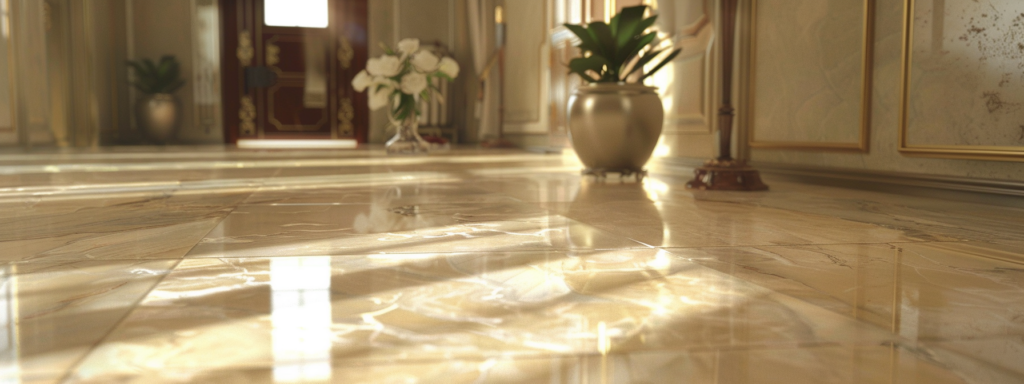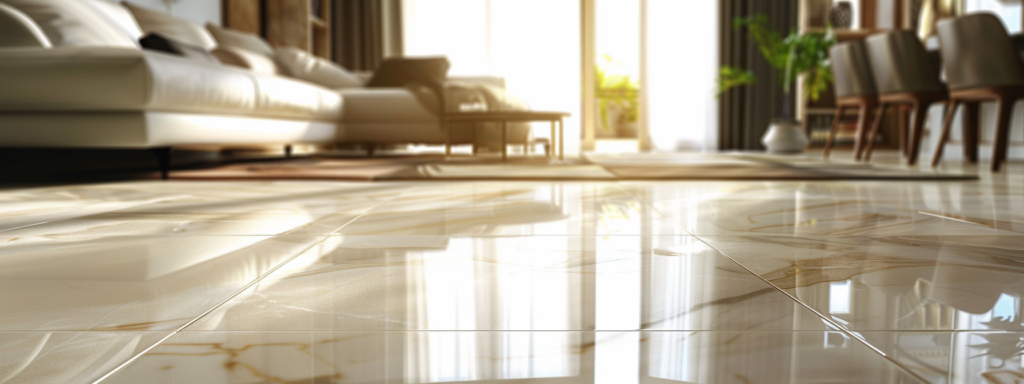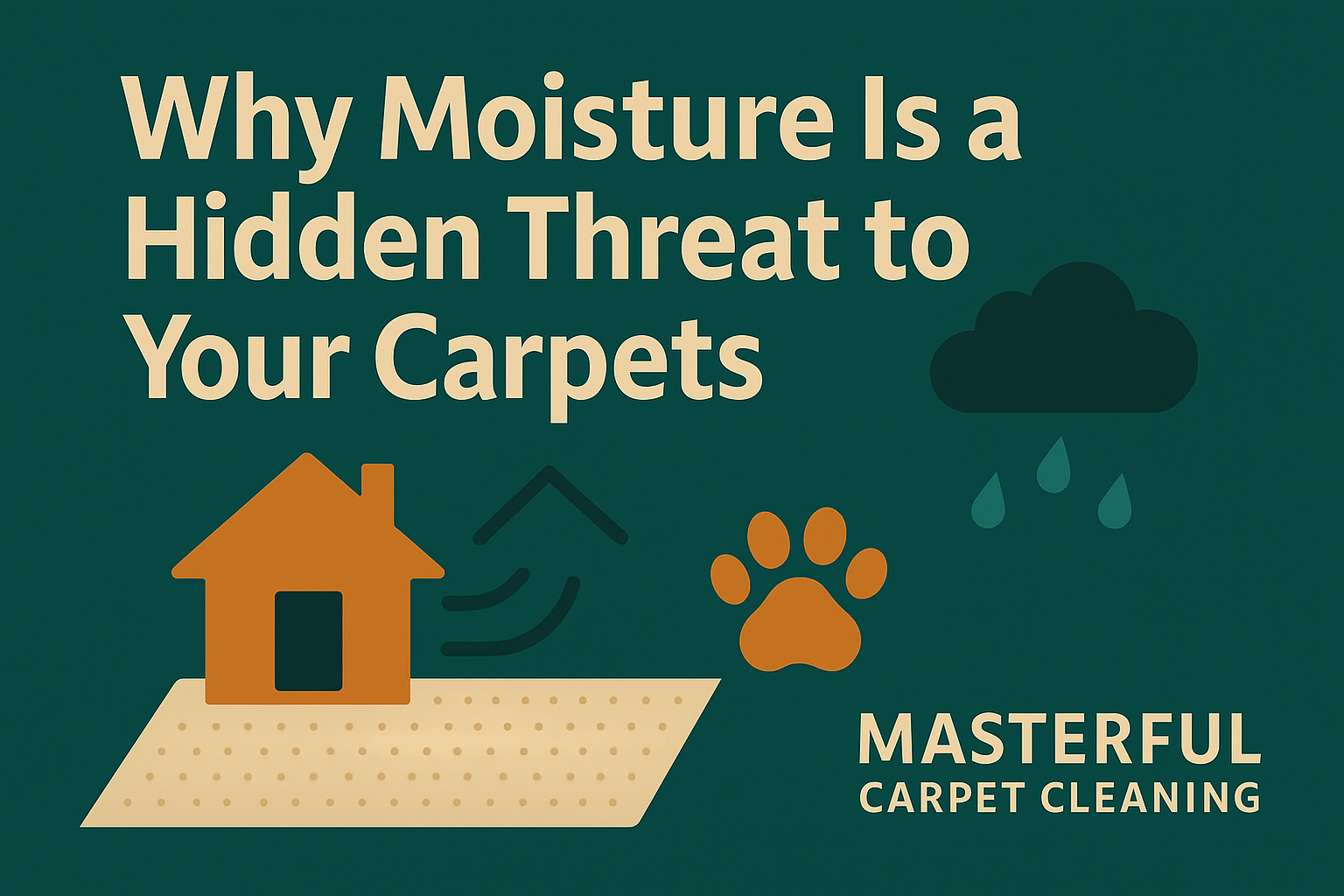Grout Cleaning for Ceramic Tiles: A Detailed Guide

Grout, the material that fills the spaces between ceramic tiles, is not just a structural component but also a significant aesthetic element in tile installations.
Its porous nature makes it susceptible to staining, dirt accumulation, and mold growth, which can detract from the tiles’ beauty and pose health risks. Regular cleaning of grout is important for maintaining the visual appeal and hygiene of tiled surfaces, ensuring they remain durable and attractive over time.
Grout and Ceramic Tiles
- What is Grout? Grout is a composite material used to fill gaps and seal joints between tiles. Typically made from a mixture of water, cement, and sand, grout is known for its porous characteristics, which make it prone to absorbing liquids and dirt.
- The Porous Nature of Grout: The porosity of grout means it can easily become stained and discolored, absorbing moisture and dirt from its environment. This absorption can lead to aesthetic and structural issues, including the growth of mold and mildew, which are not only unsightly but can also cause health problems.
Ceramic Tiles: Durability and Design
- Why Choose Ceramic Tiles? Ceramic tiles are favored for their durability, ease of maintenance, and wide variety of styles. Made by firing clay at high temperatures, these tiles come in glazed and unglazed varieties, offering options for different looks and levels of resistance to stains and water.
- Grout in Ceramic Tile Installations: Beyond aesthetics, grout is fundamental in the functionality of tile installations. It helps to evenly distribute weight across tiles to prevent cracking and serves as a barrier against water and debris, which could undermine the tiles and the surface beneath them.
Regular Maintenance: Key to Longevity and Aesthetics
Maintaining the Beauty of Grout and Ceramic Tiles
- Regular Cleaning: Incorporating grout cleaning into your routine home maintenance can significantly reduce the buildup of dirt and grime. Establishing a regular cleaning schedule helps maintain the appearance and integrity of the grout and tiles, preventing the need for extensive efforts later.
- Effective Cleaning Techniques: Utilizing the correct tools, such as stiff-bristled brushes for scrubbing and microfiber cloths for wiping, alongside suitable cleaning solutions can make the task more manageable. For daily maintenance, gentle, pH-neutral cleaners are recommended to avoid damaging the grout and tiles.
The Path to Pristine Tiles
The journey to keeping grout and ceramic tiles in pristine condition is ongoing, requiring regular attention and proper care.
By understanding the importance of grout cleaning and employing effective maintenance strategies, homeowners can ensure their tiled surfaces remain beautiful, hygienic, and durable for years to come. Embracing a proactive approach to grout and tile maintenance not only enhances the aesthetic appeal of your home but also contributes to a healthier living environment.

Routine Care for Ceramic Tiles
Maintaining the pristine condition of ceramic tiles involves regular upkeep to prevent dirt accumulation and ensure their longevity and aesthetic appeal. Here’s a guide to daily and regular maintenance tasks, along with recommendations for cleaning products and tools.
Daily and Regular Maintenance Instructions
- Dust Mopping, Sweeping, and Vacuuming: Regular removal of dust and debris is imperative. Use a soft-bristle vacuum attachment to prevent scratching the tiles. This step is essential before using any liquid cleaners to prevent dirt from turning into mud during the mopping process.
- Mopping: Mop your ceramic tile floors at least once a week with a mild dish detergent diluted in hot water. This solution is effective for general cleaning without the need for harsh chemicals. Ensure you replace the mop water as soon as it gets dirty to avoid leaving a dull residue on the tiles.
- Spill Management: Promptly cleaning up spills will prevent them from staining the tiles or seeping into the grout. A quick wipe with warm water and a bit of mild dish detergent is usually sufficient for everyday messes.
- Grout Care: Given its porous nature, grout can easily become discolored and should be sealed after installation and then periodically to protect it from stains and moisture. Sealing the grout can simplify maintenance and help prevent staining or discoloration.
Recommended Cleaning Products and Tools
- All-Purpose, Low VOC Cleaners: For routine cleaning, opt for all-purpose cleaners that are low in volatile organic compounds (VOCs) and are compatible with grout joints. These products are effective in removing soap scum, hard water deposits, and mildew without damaging the tile’s glazed surface.
- Microfiber Mops and Cloths: Use microfiber mops and cloths for applying cleaners and drying the tiles. Microfiber is effective at trapping dirt and moisture, leaving the surface streak-free and shiny.
- Specialized Tile and Grout Cleaners: For tougher stains or heavy-duty grout cleaning, professional-strength tile and grout cleaners can remove grease, soap scum, and oils. Choose products with low VOCs and without polluting chemicals to ensure the safety of your home environment.
- Soft-Bristle Brushes: A soft-bristle brush is ideal for scrubbing grout lines without causing damage. For deeper grout cleaning, you might need to use a brush along with a vinegar/baking soda paste or a hydrogen peroxide solution.
Maintaining ceramic tiles and grout requires consistent care but doesn’t have to be a daunting task. Incorporating these guidelines into your regular cleaning routine can keep your tiles looking new for years to come.
For specific product recommendations and further detailed care instructions, refer to manufacturers’ guidelines or consult with a flooring professional.

Deep Cleaning Grout
Achieving spotless grout may seem daunting, but with the right approach and homemade solutions, you can revitalize even the dingiest grout lines. Follow this step-by-step guide to deep clean your grout effectively:
Step-by-Step Instructions for Deep Cleaning Grout
- Preparation: Begin by sweeping or vacuuming the area to remove any loose dirt. This prevents scratching the tile or embedding dirt deeper into the grout during the cleaning process.
- Mix Your Cleaning Solution: For an effective homemade cleaner, combine equal parts of hot water and white vinegar in a spray bottle. This mixture is effective for general grout cleaning and is environmentally friendly.
- Application: Spray the cleaning solution generously over the grout lines, ensuring thorough coverage. For tougher stains or areas, you might consider a paste made from baking soda and hydrogen peroxide.
- Dwell Time: Allow the solution or paste to sit on the grout for 5 to 20 minutes, depending on the level of soiling. This dwell time helps the cleaning agents penetrate and break down the dirt and stains.
- Scrubbing: Using a small brush, such as an old toothbrush or a grout brush, scrub the grout lines vigorously to loosen and remove the dirt. The type of brush and your scrubbing technique (circular or back-and-forth motion) can vary based on the grout line size and tile type.
- Rinsing: After scrubbing, rinse the area thoroughly with clean water. For shower walls, you might use the showerhead, while a damp mop or cloth works well for floors.
- Drying: Wipe the area dry with a clean cloth or allow it to air dry completely to prevent any water marks or residue.
Homemade Grout Cleaning Solution
For a more targeted approach to stubborn grout stains, consider using a paste made from baking soda and hydrogen peroxide. Here’s how to prepare and use this potent cleaning duo:
- Ingredients: Mix one part baking soda with one part hydrogen peroxide to form a thick paste.
- Application: Apply this paste directly onto the grout lines and let it sit for about an hour. This allows the cleaning agents to penetrate deeply into the grout’s porous surface.
- Scrubbing: After the dwell time, scrub the area with a brush to remove the loosened grime and discoloration.
- Cleanup: Use a damp cloth or mop to wipe away the paste, rinsing thoroughly to ensure all residue is removed.
This homemade solution is effective for brightening and cleaning grout without the harsh effects of chlorine bleach, which can discolor and damage grout over time.
For maintaining the cleanliness and appearance of your grout after deep cleaning, consider applying a grout sealer. This can help protect the grout from future staining and make routine cleaning easier.
By following these steps and using these homemade solutions, you can restore the appearance of your grout, making your tiled surfaces look as good as new.

Natural Alternatives for Grout Cleaning
Natural cleaning solutions leverage the power of household items like baking soda and hydrogen peroxide to cleanse without harsh chemicals.
These options are not only effective for cleaning grout’s porous surfaces but are also safer for the environment and household use. They are particularly praised for their non-toxic properties, ensuring no harmful residues are left behind, making them a preferred choice for homes.
Instruction for Homemade Paste:
To tackle grout cleaning naturally:
- Mixing the Paste: Combine baking soda and hydrogen peroxide in equal parts to form a paste. This blend uses the mild abrasiveness of baking soda and the brightening properties of hydrogen peroxide to clean without damaging the grout.
- Application: Apply this paste directly onto the grout lines. Allow it to sit for about an hour, giving the mixture enough time to break down the dirt and stains.
- Scrubbing: After the waiting period, use a small brush (an old toothbrush works well) to scrub the grout thoroughly, removing any accumulated grime.
- Rinsing and Drying: Finish by wiping the area with a damp cloth and rinsing well to ensure no paste residue is left. Allow the area to dry completely.
Grout Care and Maintenance
Sealing Grout: Sealing grout is a critical maintenance step to prevent staining and facilitate cleaning. Once your grout is clean and dry, apply a sealer as per the product instructions. This protective layer helps to repel moisture and stains, making future cleaning tasks easier. Select a sealer that matches the needs of your tile type and grout material.
Removing Sealers, Waxes, and Floor Finishes: When it’s time to remove old sealers, waxes, or finishes from ceramic tiles, choose a product formulated specifically for this purpose. Before applying broadly, conduct a spot test to avoid potential damage. Apply the product generously, wait for it to soften the unwanted layer, then wipe clean with a towel or sponge. Rinse thoroughly with clean water to remove any remaining product.
By adopting these natural cleaning methods and proper maintenance techniques, you can keep your grout in excellent condition, extending the lifespan of your tiled surfaces in an eco-friendly manner.
Troubleshooting Common Grout Cleaning Issues
Q: Does bleach damage grout?
A: Yes, bleach can damage grout over time. Although it’s a powerful cleaner, bleach is highly alkaline and can break down the cement in grout, leading to brittleness and cracking. This allows moisture and dirt to seep in, potentially causing further damage. Bleach can also cause discoloration or staining of the grout if not used correctly.
Q: Is vinegar safe to use on grout?
A: Vinegar, while popular for its cleaning properties, can be too acidic for grout, especially if it’s sealed. Its acidic nature can dissolve the sealer on the grout and tile, allowing dirt, oils, and stains to penetrate more deeply. Over time, vinegar can cause grout to break down, leading to uneven tile finishes and potential damage.
Q: Can I use ammonia, lemon juice, or toilet bowl cleaner on grout?
A: These substances are not recommended for cleaning grout. Ammonia’s high alkalinity, lemon juice’s citric acid, and the corrosive nature of toilet bowl cleaners can damage grout and dissolve its sealer. Additionally, dyes in some cleaners can permanently stain grout.
Q: What about using muriatic acid to clean grout?
A: Muriatic acid should not be used on floor tile or grout. It’s a strong acid that can corrode grout, damage tile finishes, and cause permanent damage to both tile and grout.
Q: Are there safer alternatives to clean grout without causing damage?
A: Yes, safer alternatives include using grout-safe natural cleaners like hot water, baking soda, Dawn dish soap, and most hydrogen peroxide solutions. Cleaners specifically made for grout and tile are also safe. For example, Black Diamond Ultimate Grout Cleaner and Grout-Eez Heavy Duty Grout Cleaner are good commercial options.
Proper maintenance of grout and ceramic tiles is important for their longevity and aesthetics. While bleach and vinegar are common household cleaning agents, their use on grout requires caution due to potential damage.
Natural alternatives and specific grout cleaners offer safer options for maintaining the cleanliness and integrity of grout lines. Regular cleaning, careful selection of cleaning agents, and periodic sealing of grout can help preserve the appearance and durability of tiled surfaces.
Author
-

As the Co-Owner of Masterful, Randy has been providing quality cleaning services to the Salem and Portland areas of Oregon for many years. He has built a reputation for excellence in the industry. His team take prides in using the latest cleaning techniques and technologies to deliver exceptional results every time.
View all posts








